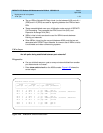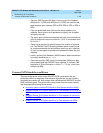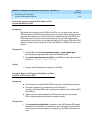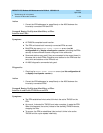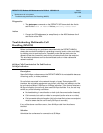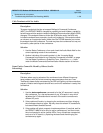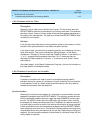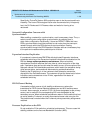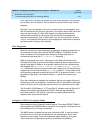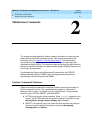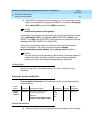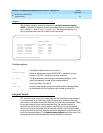
DEFINITY ECS Release 8.2 Maintenance for R8.2csi
555-233-119 Issue 1
April 2000
Maintenance for csi systems
1-139Troubleshooting Multimedia Call Handling (MMCH)
1
Voice-Activated Switching Problems
Voice-activated switching on the DEFINITY MMCH does not follow the loudest
talker. The MMCH queues all speaking parties and selects a new video
broadcaster (the second-oldest speaking party) when the oldest speaking party
has stopped talking. The new broadcaster will see the last speaker as its video.
The system can also “learn” about the noise coming from an endpoint to help
prevent false switches, adapting both to noise level and repetitive sounds such
as a fan. This adaptation occurs over approximately 10 seconds.
No Switching, Full Motion Video
If a room is excessively noisy, the DEFINITY MMCH may receive sufficient audio
signal to conclude that there is a speaker present. Use the Status Conference x
form to determine if the MMCH thinks an endpoint is talking. The MMCH sets the
Ts
field to
t
for each endpoint if there is voice energy detected. This endpoint
may have to mute when nobody at the site is speaking to allow the conference to
proceed normally. Remind the customer that it may be necessary to mute if a
side conversation is going on in the background, just as one would do in an
audio conference. If the system does not switch broadcasters even after the
current broadcaster has muted, check the conference administration using the
display conference X
command to ensure that the conference is in
voice-activated mode. Also verify that parties who were speaking are valid video
sources as described in the “
Calls Terminate with No Video
” section above.
The See-Me feature (MCV) can also cause VAS to “lock-up.” An endpoint can
activate MCV to force their site to become the broadcaster. If they do not disable
the feature when finished, the system remains in this mode indefinitely. Beginning
with Release 3.0, the
status conference X
command shows that MCV is in effect
by displaying
av
in the Video Status (Vs) column. Page 3 of the Status
Conference X Endpoint Y form also has a
Broadcaster
field that indicates MCV
is in effect with (SEE-ME) as the broadcaster. The same scenario can occur in a
CHAIR or UCC-controlled conference with a designated broadcaster. In this
situation the CHAIR/UCC has not released the designated broadcaster and
returned to VAS mode. If there is a UCC-designated broadcaster,
status
conference X
indicates a Video Status of
u
. Also, for UCC rollcall the return
video may appear to be stuck. Check the Video Status for an “
R
,” indicating
rollcall.
If none of the examples above appears to be the cause, and if the room was
quiet, all speakers are valid video sources, the conference is voice-activated,
and the speaker can be heard, then escalate the problem.



